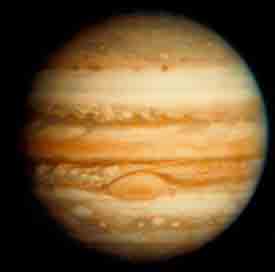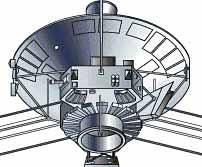|
         
> The Sun
> Mercury
> Venus
> Earth
> Mars
> Jupiter
> Saturn
> Uranus
> Neptune
> Pluto
> The 10th Planet?
> Asteroids
> Comets
> The 'Edge'
  
|
Jupiter is a gas giant.
This means that it has a huge atmosphere, a liquid mantle, and a liquid /
solid core, with no definite boundary between the layers.
The core of Jupiter is probably composed of liquid rock, at a temperature
as high as 24,000 K (43,000 įF). The core is small relative to the planet,
about 20% of its radius, but it is still fifteen times heavier than the
Earth.
Next comes a layer of liquid hydrogen that is under the pressure of
10,000,000 Earth atmospheres. This changes the nature of the hydrogen in such a way that it
is able to conduct electricity as metal does, so it is called "metallic
hydrogen." This generates the planet's magnetic field which is 20,000
times stronger than Earth's. This layer also makes up most of the planet
atmospheres. This changes the nature of the hydrogen in such a way that it
is able to conduct electricity as metal does, so it is called "metallic
hydrogen." This generates the planet's magnetic field which is 20,000
times stronger than Earth's. This layer also makes up most of the planet
The layer on top of this is ordinary liquid hydrogen. This makes up the
upper 25% of the planet.
Next, the hydrogen thins out into the gaseous atmosphere which is 1000 km
(620 miles) deep. It is composed mainly of hydrogen and helium with trace
amounts of methane, water, ammonia, and hydrogen sulfide. Some scientists
believe that there are also polysulphur compounds and phosphine which lend
their colors to the clouds.
Jupiter also has a faint ring system. It is comprised of one main ring,
with fuzzier "gossamer" rings farther out. The system is only a few
thousand kilometers from the sharp outer edge to the inner fuzzy edge,
which continues to the planet's atmosphere. The picture at left was taken
by the Galileo spacecraft when the sun was behind Jupiter, so the rings
were backlit.
Exploration
The US Pioneer 10 and 11 spacecraft, launched in 1972 and 1973, passed
safely through the unexplored asteroid belt beyond the orbit of Mars and
flew by Jupiter in December 1973 and December 1974. The two 258-kg
(570-lb) spacecraft passed the planet at a distance of 130,400 km (81,000
mi) and 46,700 km (29,000 mi), respectively, after which Pioneer 10
continued on its way out of the solar system, the first craft ever sent
into interstellar space; it is expected to encounter its first star in
about 80,000 years. Pioneer 11 passed by Saturn in September 1979,
preparing the way for Voyagers 1 and 2.
 |
Pioneer Space Probe
The Pioneer series of United States
space probes was equipped with cameras and instruments to detect
subatomic particles, meteorites, and electric and magnetic fields in
the solar system and interstellar space. |
[Top]
Unique Characteristics
Jupiter has three main unique characteristics. The first one is its
immense size. It is indeed, as its name suggests, the king of the planets.
About 1,320 Earths could fit inside of it.
The second characteristic is the Great Red Spot. This is a gigantic (three
Earth diameters) storm that has existed for more than three centuries
(Galileo discovered it in the seventeenth century). It will probably
continue to exist for hundreds or thousands of years, for it is constantly
being fed by smaller eddies surrounding it, such as the white spots in the
picture at the right.
The third characteristic is its many moons. Jupiter has the most moons of
any planet in the solar system: 61.
[Top]
Jupiter's Satellite
There are the four Galilean satellites. They are named so because they
were the only four moons that Galileo was able to see. They are also the
largest of Jupiter's moons. They are Ganymede, Callisto, Europa, and Io.
If Ganymede were not bound to Jupiter, it would be considered a planet in
its own right. It is actually bigger than Mercury, being 390 km (234
miles) larger in diameter. It has heavily cratered dark regions, with
lighter expanses in-between. Geologists think that it used to have plates,
like the Earth, but they froze together soon after Ganymede's birth.
Callisto, the outermost of the Galilean moons, is almost an exact twin of
Mercury in size and appearance. Every square mile is covered with craters
or other signs of bombardment. Other than that, there are no distinct
characteristics
Europa, closer to Jupiter than Ganymede, is the smoothest natural body in
the solar system. It resembles a billiard ball until seen very close-up.
At that distance you can start to see dark, deep, and narrow cracks. In
scale, though, the relief is no bigger than a line on a billiard ball made
with a felt-tipped marker. Geologists think that Europa has liquid water
underneath the icy surface - and possibly life.
Io, closer yet, is commonly compared to a pizza. Its volcanoes make it the
most active world in the solar system. They spew out the sulfuric acid
that gives Io its many colors. They also make Io one of the only three
moons with an atmosphere in the solar system. Saturn's Titan and Neptune's
Triton are the other two moons. Io is similar in size and composition to
our moon. Io is caught in the middle of a tug-of-war between Jupiter and
the other moons. Tension has melted the interior and raised the surface
temperatures so high that scientists calculated that it generates the most
heat for its size of any body in the solar system, except for the sun.
[Top]
Other Satellites
There are 57 other moons that have been discovered around Jupiter.
There are four closer than Io. Their names, in order from Jupiter are
Metis, Adrastea, Amalthea, and Thebe. Still in order after the Galilean
Satellites are recently discovered Themisto, Leda, Himalia, Lysithea, and
Elara. Then there are four more recently discovered moons, Ananke, and
three more moons, of which scientists know little about. After these seven
come Ananke, Carme, PasiphaŽ, and Sinope, with two more moons in-between
PasiphaŽ and Sinope. After Sinope, 12 more moons are found.
The outer 33 moons all orbit Jupiter in a direction opposite (except for
J/2003 J20) to that which Jupiter spins, which leads scientists to believe
they are captured asteroids.
The largest non-Galilean moon is Amalthea, being 262 km (163 miles) at its
widest diameter.
The innermost two moons, Metis and Adrastea, patrol the outer edge of the
rings, their small gravity being enough to keep the particles from flying
out.
The recently discovered moons are tiny, and orbit retrograde, an almost
certain indication that they are captured asteroids rather than being
native to the system. They are currently being called S/2001 J# with the #
ranging from 1 to 11, S/2002 J1, and S/2003 J1-21. They will eventually be
given names by the International Astronomical Union, the only official
naming group.
[Top]
External Links
[Back] [Top] [Next] |
 atmospheres. This changes the nature of the hydrogen in such a way that it
is able to conduct electricity as metal does, so it is called "metallic
hydrogen." This generates the planet's magnetic field which is 20,000
times stronger than Earth's. This layer also makes up most of the planet
atmospheres. This changes the nature of the hydrogen in such a way that it
is able to conduct electricity as metal does, so it is called "metallic
hydrogen." This generates the planet's magnetic field which is 20,000
times stronger than Earth's. This layer also makes up most of the planet